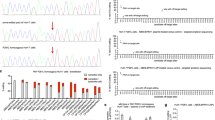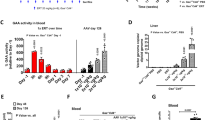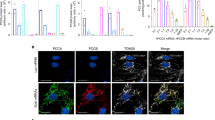Abstract
Current therapy for phenylketonuria (PKU) consists of life-long dietary restriction of phenylalanine (Phe), which presents problems of adherence for patients. Alternative therapies under investigation include, among others, the use of gene therapy to provide copies of wild-type, non-mutant, phenylalanine hydroxylase (PAH) enzyme. Expression of PAH in both liver (the usual metabolic source of this enzyme) and skeletal muscle is under investigation. Liver gene therapy, using a viral vector based on the adeno-associated viruses (AAVs), provided effective clearance of serum Phe that was sustained for 1 year in some mice. In order for PAH expression to be effective in skeletal muscle, the essential metabolic cofactor, tetrahydrobiopterin (BH4), must also be provided, either by supplementation or gene therapy. Both these approaches were effective. When transgenic PKU mice that constitutively expressed PAH in muscle were given intraperitoneal supplementation with BH4, this produced (transient) effective clearance of Phe to normal levels. In addition, use of an AAV vector containing the genes for PAH, and for two key synthetic enzymes for BH4, provided substantial and long-lasting correction (more than 1 year) of blood Phe levels when injected into skeletal muscle of PKU mice. These two strategies provide promising treatment alternatives for the management of PKU in patients.


Similar content being viewed by others
Abbreviations
- AAV:
-
adeno-associated virus
- BH4 :
-
tetrahydrobiopterin
- CMV:
-
cytomegalovirus
- EC:
-
Enzyme Commission
- ENU:
-
N-ethyl-N-nitrosourea
- GTP:
-
guanosine triphosphate
- GTPCH:
-
guanosine triphosphate cyclohydrolase I
- ITR:
-
inverted terminal repeat
- OMIM:
-
Online Mendelian Inheritance in Man database
- PAH:
-
phenylalanine hydroxylase
- Phe:
-
phenylalanine
- PKU:
-
phenylketonuria
- PTPS:
-
6-pyruvoyl-tetrahydropterin synthase
- rAAV:
-
recombinant adeno-associated virus
- SR:
-
sepiapterin reductase
- WPRE:
-
woodchuck hepatitis virus post-transcriptional element
References
Ding Z, Georgiev P, Thöny B (2006) Administration-route and gender-independent long-term therapeutic correction of phenylketonuria (PKU) in a mouse model by recombinant adeno-associated virus 8 pseudotyped vector-mediated gene transfer. Gene Ther 13:587–593
Ding Z, Harding CO, Rebuffat A, Elzaouk L, Wolff JA, Thony B (2008) Correction of murine PKU following AAV-mediated intramuscular expression of a complete phenylalanine hydroxylating system. Molec Ther 16:673–681
Harding CO, Wild K, Chang D, Messing A, Wolff JA (1998) Metabolic engineering as therapy for inborn errors of metabolism—development of mice with phenylalanine hydroxylase expression in muscle. Gene Ther 5:677–683
Jung SC, Park JW, Oh HJ, Choi JO, Seo KI, Park ES, Park HY (2008) Protective effect of recombinant adeno-associated virus 2/8-mediated gene therapy from the maternal hyperphenylalaninemia in offsprings of a mouse model of phenylketonuria. J Korean Med Sci 23:877–883
Nagasaki Y, Matsubara Y, Takano H, Fujii K, Senoo M, Akanuma J et al (1999) Reversal of hypopigmentation in phenylketonuria mice by adenovirus-mediated gene transfer. Pediatr Res 45:465–473
Rebuffat A, Harding CO, Ding Z, Thöny B (2009) Comparison of AAV pseudotype 1, 2, and 8 vectors administered by intramuscular injection in the treatment of murine phenylketonuria. Hum Gene Ther. doi:10.1089/hum.2009.127
Shedlovsky A, McDonald JD, Symula D, Dove WF (1993) Mouse models of human phenylketonuria. Genetics 134:1205–1210
Thöny B, Auerbach G, Blau N (2000) Tetrahydrobiopterin biosynthesis, regeneration and functions. Biochem J 347:1–16
Wu Z, Asokan A, Samulski RJ (2006) Adeno-associated virus serotypes: vector toolkit for human gene therapy. Molec Ther 14:316–327
Acknowledgements
The authors take full responsibility for the content of this meeting report but thank Caudex Medical (supported by Serono Symposia International Foundation) for their assistance in preparing the initial draft of this report and collating the comments of authors and any other named contributors. This work was supported by grants to B.T. from the Anna Müller Grocholsky Foundation, the Hartmann Müller Foundation, the Stiftung für wissenschaftliche Forschung an der Universität Zürich, the Novartis Stiftung für Medizinisch-Biologische Forschung, and continuous support by the Swiss National Science Foundation.
Author information
Authors and Affiliations
Corresponding author
Additional information
Communicated by: Nenad Blau
Competing interest: None declared.
Reference to electronic databases: EC, OMIM
Rights and permissions
About this article
Cite this article
Thöny, B. Long-term correction of murine phenylketonuria by viral gene transfer: liver versus muscle. J Inherit Metab Dis 33, 677–680 (2010). https://doi.org/10.1007/s10545-010-9044-3
Received:
Revised:
Accepted:
Published:
Issue Date:
DOI: https://doi.org/10.1007/s10545-010-9044-3




